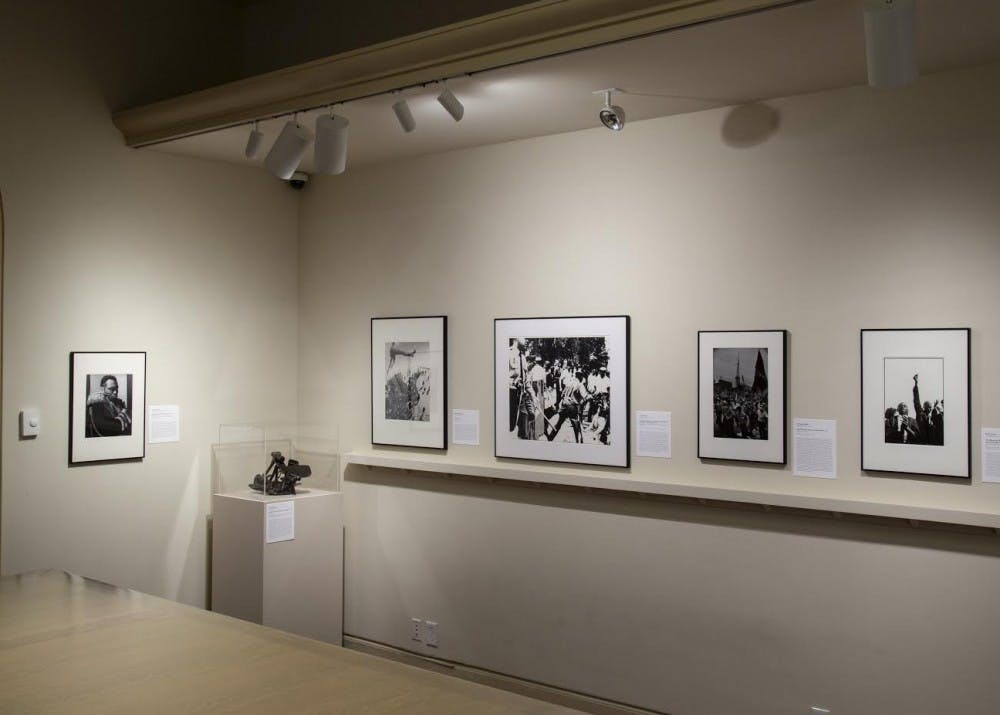What do you think of when you think of the word “protest?” After huddling around a black silhouette emerging from a pop-up book, fourth-year University Museums Intern Victoria Armstrong asks viewers of the Fralin Museum of Art’s “Art of Protest” exhibition to answer this question.
Curated by 10 University Museums Interns with the help of academic curator M. Jordan Love, “Art of Protest” orchestrates a collection of black-and-white photos and objects depicting a long history of dissent throughout the twentieth century. The Saturday Special Tour, led by Armstrong, fourth-year College student Meghan Smith, third-year College student Sarah Frost and fourth-year College student Hannah Hicks, focused on a surprising scene from a pop-up book by Kara Walker, as well as stirring photographs by Danny Lyon and Barbara Morgan. The exhibit also includes works by Ed Roseberry, Melvin Edwards and Andy Warhol.
With the “Unite the Right” rally and counter-protests last August in mind, “Art of Protest” deepens viewers’ understanding of political activism.
“Protest is an inherent part of the human experience,” Frost said. “People have been protesting for centuries about causes they care about in order to create some kind of positive change.”
Timeless photographs depicting moments from the Civil Rights Movement, namely the March on Washington and even a Chuck Berry performance, contain potent relevance. Even when analyzing a surrealist photograph with anti-fascist undertones, viewers will easily make connections to recent protests — from Ferguson to Charlottesville to “March For Our Lives” in Washington, D.C.
As such, “Art of Protest” is relevant both at a national level and a local level. Before the tour, Smith gave an acknowledgement “paying respect to the Monacan Nation, the traditional custodians of the land we’re on today,” as well as recognition of the enslaved laborers who constructed the University. While members of the University Museums Internship class wishes there were more artists of color in the exhibition, they hope sharing stories of protest and including works by African-American artists will move dialogue forward in tandem with a “nationwide push for museums to become more inclusive,” especially when art history historically pushes people of color to the side.
“We really wanted to use the space as a counter-narrative to the dominant exhibition on Thomas Jefferson,” Hicks said. “While [the Thomas Jefferson exhibition] is a great exhibition, we noticed there wasn’t a lot of information on the enslaved laborers that contributed to his accomplishments.”
A metal sculpture by Melvin Edwards and a pop-up book titled “Freedom, A Fable” by Kara Walker in particular create conversation about America’s history of exploiting enslaved laborers.
“[Kara Walker’s piece] is the most subtle and maybe romantic of all her works because the rest of her subject matter is usually very violent and explicit — and a little grotesque,” Smith said. “She’s playing with racial stereotypes in most of her work.”
Kara Walker is a contemporary American artist who focuses on race, identity and sexuality. Her baroque silhouette of a young woman laying on her back holding a flower under a palm tree in “a deep meditation on the nature of her New World” appears unfamiliar at first in an exhibition with many two-dimensional historic photographs. However, Walker’s three-dimensional world reveals that art — in all its forms — is endlessly linked to social change.
Equally intimate is a photograph by American photographer Danny Lyon depicting the faces of two young black men in a multi-generational crowd gathered for the March on Washington in August of 1963. A raised arm stretches confidently into the white sky to snap. Claps and gospel songs are easy to imagine.
More dreamlike is a piece by American photographer Barbara Morgan, well-known for her presentation of dancers in the 1930s and 1940s. Above an ant-like horde of people gathered in a crowd, a superimposed pair of white, bare and muscular legs readies itself like a toy soldier to step on the swarm.
“Does that make you feel that protest is futile, in a way?” Hicks asked.
A few viewers uttered a somber “ugh” in response. Others mentioned how uplifting unity could feel. Certainly, “Art of Protest” sparks conversation. Visiting former Fralin curator Stephen Margulies remarked that the pieces in the exhibition even appear to be having a conversation with each other.
As a whole, the black and white selections are visibly striking, politically thoughtful and cohesive. History buffs will enjoy the variety of decades depicted, artists will appreciate the harmony between different mediums, and anyone who has followed the news lately will be intrigued by the discussion “Art of Protest” naturally provokes.







